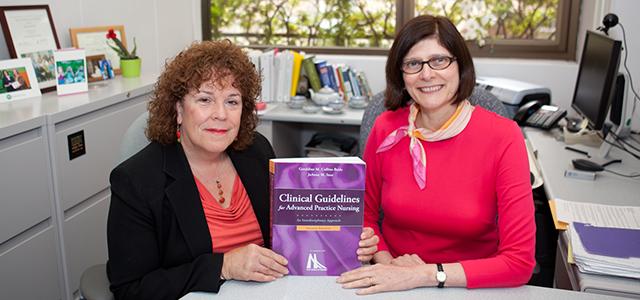
Gerri Collins-Bride, MS, RN, FAAN, and JoAnne Saxe, DNP, RN, FAAN (photo by Elisabeth Fall)
Adapting to the Changing Role of Advanced Practice Nurses
A conversation with Gerri Collins-Bride, MS, RN, FAAN, and JoAnne Saxe, DNP, RN, FAAN, authors of the recently released Clinical Guidelines for Advanced Practice Nursing: An Interdisciplinary Approach
What need does your new book fill?
Gerri: Well, first, I want to emphasize that this was really a schoolwide effort. We’ve had so many contributing authors from our faculty here at the School – they really represent the bulk of the authors.
JoAnne: Yes. Absolutely. As for need, the greatest need was around the management of chronic illnesses, rather than acute conditions.… There aren’t a lot of clinical care guidelines where the emphasis is on chronic disease management from a multiprofessional perspective. This book has contributions not only from advanced practice nurses – NPs, clinical nurse specialists, midwives – but we also have contributions from our physician colleagues, nutritionists, clinical psychologists and the list goes on. It has a depth that the clinician can appreciate.
There are a couple of chapters that demonstrate the multiprofessional perspective quite well. One is on chronic pain – it reflects the team-based care offered at GLIDE Health Services, as an example.… Also, people with chronic conditions oftentimes have comorbid mental health issues. And we made sure there were a number of chapters that addressed common mental health concerns, such as depression and anxiety.
G: We tried to pick conditions not easily Googled or found in the literature, things the clinician would come up against in practice and for which it would be helpful to have a resource.… The chapter I wrote on health promotion for individuals with developmental disabilities, that is something you will not find anywhere else in the literature because it just doesn’t exist. We tried to also pick some target populations that NPs and other clinicians are seeing frequently in practice, but we’re not seeing much about in the literature. So health promotion for transgender individuals, for adults with developmental disabilities…
In addition to the chronic disease focus, we’ve got a very strong focus on health promotion. As nurse practitioners, as advanced practice nurses, that is one of the areas we feel is a strength and a core value of our practice.…
I also want to highlight a chapter on developmental screening and assessment for developmental delays and autism. We know they’re getting a lot of play in the literature and we wanted to be sure those practicing in that age group had the right tools for screening of developmental delays.
J: There is also the chapter on legal aspects of practice…because we are all under the rigor of regulations and it’s important to be vigilant about our scope of practice, where it overlaps with medicine, vigilant around business regulations that would impact our ability to be reimbursed.
G: Understanding business and legal issues is really key to anyone in clinical practice.
J: That’s one of the areas where when we get into an online format, we can develop and expand.
What are some of the book’s key takeaways?
G: Health care has really become team-based. It’s a team effort with the patient and the family and the caregivers always at the center, but clinicians need support from multiple disciplines in order to provide good care. The other thing that comes through is empowering patients and families with education. Those patient education sections are really important because we want our patients…to be as informed and engaged consumers as possible in their own health care.
J: Another important message is that there need to be tools to push our memory a bit around the care. So we have some decision-making tools that make it a little easier to guide the clinician through history taking for the physical exam, to thinking about the myriad of diagnostic studies, and the importance of engaging patients and caregivers in their care.
In writing the book, did you consider how increasing emphasis on measuring patient outcomes affects clinical practice?
J: Yes. More and more consortiums of clinics and hospitals are looking at specific diseases that are prevalent in their clinical environment, agreeing on indicators that are most important, and collecting data around those indicators.
So I’ll use GLIDE as an example. We’ve been monitoring outcomes of care related to diabetes for a number of years. One of the indicators revolves around having diabetics on certain types of blood pressure medication that we know are not only effective in controlling their blood pressure, but help to protect their kidneys. And so that indicator is a simple and elegant one: how many people with diabetes over the age of 50 are on an ACE inhibitor for their hypertension? And we’ve been able to trend that over time – in our clinical setting, but with other clinics in the [San Francisco Community Clinic Consortium] as well.… It helps to put a little necessary pressure, if you will, to continue to do better, because we’re comparing notes with other clinical settings. On most of the indicators we’ve exceeded the benchmark.…
The collection of data has also encouraged clinical environments to have really solid quality improvement teams that are interprofessional in nature, and we come up with very specific quality improvement plans to do a better job. So it’s not just the data; it’s now that you have the data, what do you do with it?
What role are electronic health records playing in gathering data, enhancing measures and changing practice?
G: I think the possibilities are almost endless…not only in terms of delivering better care – being able to actually see notes from another practice quickly, to get results quickly, to have patients be able to access you very quickly and directly – but also for our practice as advanced practice nurses. We’re going to be able to collect better data, not just on how many patients we see, but the type of patients we see, the complexity of patients, our targets at quality improvement and how we’re doing. I actually think there will be so much information that it will allow us to ask better questions about our practice and study them in a more systematic way.… I wouldn’t have said this a year ago, because I was just starting and it was a painful process, and I’m certainly not expert yet, but I can see the light at the end of the tunnel.… I think ultimately we can contribute to national data sets in terms of NP practice as well as quality indicators for patient care.
What types of questions will the data from EHRs generate?
J: … Nursing sensitive questions, so that we can look at indicators that show there’s an added value. We’ve already demonstrated our capacity to provide excellent primary care. And we can provide up to 85 percent of the care that a physician can – it’s been shown over and over again in a number of studies – but what makes us different? What is the added value? If we ask the right questions, we’ll be able to measure something that I think is way cool. So it might be around questions related to case management.…
G: Patient education, patient and family empowerment.
J: One really tiny question we’ve asked at GLIDE when patients do their patient satisfaction survey: Where would you go to get your care if you didn’t go to GLIDE? We’ve been able to demonstrate through their words, their stories, if they didn’t come here they would be showing up at the emergency department. And the [San Francisco] Department of Public Health and Saint Francis [Memorial Hospital] really want to make a major effort at keeping people out of the ED, given how expensive the care is.
G: It may inform us as to what we need to be teaching our students. Is what we’re seeing in practice being reflected in how we’re educating our students, our curriculum, our clinical residencies? So that’s one area. [It will] also allow us to tell the public a little more about what the [NP] role is and what we are doing in terms of our own patient care.



